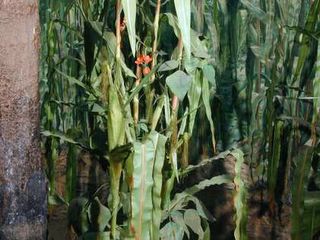Three Sisters Gardening; A Native American Method
by Lydia Daffenberg

If you're interested in gardening, you may want to experiment with a Native American method of agriculture this year in your vegetable garden. It would make sense that the Native Americans would be one up on their fellow Americans when it comes to agriculture. After all, they had been employing its practice on this fertile land hundreds of years before the white settler seeded his first corn plant. It is their expertise of living off the land that enables them to teach us a thing or two when it comes to gardening, especially organic gardening.
I came across the Three Sisters planting method when I was living close to the Oneida Reservation located near Green Bay, Wisconsin. The Three Sisters are corn, beans, and squash. This companion method planting is mutually benefical for the plants. The corn becomes support for the climbing beans which produce and release nitrogen back into the soil that the corn depletes. The squash acts as a living mulch of sorts by keeping weed growth down and helping retain soil moisture.
The plants are grown on a mound approximately 1' high and 20" wide. A few corn seeds are sown in the center of the hill. After the corn is about 6" tall, the beans and squash are planted around the corn. The original beans used were a climbing variety, and may be hard to find, but any bean plant will release nitrogen into the soil and climb to some extent. Each mound needs quite a bit of space in-between so the squash can sprawl down the hills and across the ground.
The term “Three Sisters” emerged from the Iroquois creation myth. It was said that the earth began when “Sky Woman” who lived in the upper world peered through a hole in the sky and fell through to an endless sea. The animals saw her coming, so they took the soil from the bottom of the sea and spread it onto the back of a giant turtle to provide a safe place for her to land. This “Turtle Island” is now what we call North America.
Sky woman had become pregnant before she fell. When she landed, she gave birth to a daughter. When the daughter grew into a young woman, she also became pregnant (by the West wind). She died while giving birth to twin boys. Sky Woman buried her daughter in the “new earth.” From her grave grew three sacred plants—corn, beans, and squash. These plants provided food for her sons, and later, for all of humanity. These special gifts ensured the survival of the Iroquois people.(1)
1. Erney, Diana. 1996. Long live the Three Sisters: Organic Gardening. Nov. p. 37-40.



6 Comments:
Hello! Just wanted to say I loved this post - and that I have a business by this name. We own an Organic CSA (Community Supported Agriculture) called Three Sisters Organics. This is the exact reason we named our business and it also helps that we happen to have 3 daughters too! Have you ever read the book 'Brother Crow, Sister Corn'? Great book on Native American Agriculture. Great post and good luck with your Three Sisters Garden.
Angie
Neato! Hmmm, I just started a few seeds a couple of days ago. I really want to try this though, I started some peas which I thing will suffice in the bean category, perhaps my canteloupes will act in place of the squash, but maybe not. I wasn't going to try corn but it seems to be central to the process. Well, maybe I can find some already started seedlings...Thanks for this post, as usual, it rocks!
angie,
Hi! Funny coincidence you happened upon this post!
I haven't read Brother Crow, Sister Corn, but it sounds like something I'd be interested in. I'll have to look around for it. Thanks for the tip!
Happy Gardening.
mamagiggle,
The companion-method link in the article has a chart of plants that work together, and also notes ones that do not.
It shows that peas work with corn, beans and cucumber. I'm not too familiar with growing melons, but it seems the effect should be the same as long as the spreading plants have broad leaves.
I started some seeds too: tomatoes, cherry tomatoes, lettuce, peppers, marigolds (to keep pests out of garden, they don't like the smell), oregano and basil. All but the lettuce and peppers are up.
Cheers.
What an incredibly cool concept! I knew (from Momma--gardener extraordinaire)about the advantages of companion planting, e.g./ roses and garlic (or tomatoes and roses? I was never a good listener and my memory is even worse!). As I have lived most of my adult life in apartments I haven't had much opportunity to try such a technique...but now might just consider giving it a try in our Indiana clay/ corn field...oops! I mean, our back yard.
Hey, you have a great blog here! I'm definitely going to bookmark you!
I have a backyard gardening
site/blog. It pretty much covers backyard gardeningrelated stuff.
Come and check it out if you get time :-)
e cigarette health, ecig forum, e cigarette, buy electronic cigarette, electronic cigarettes, electronic cigarette brands
Post a Comment
<< Home